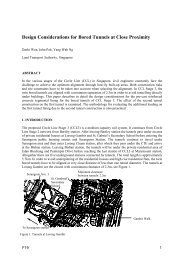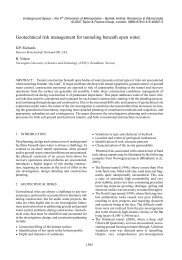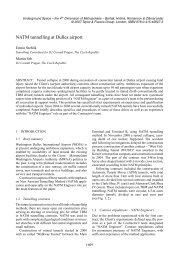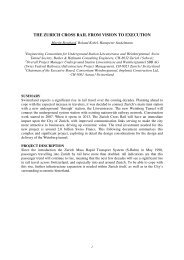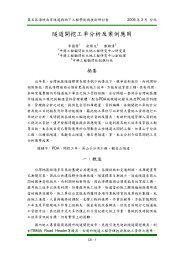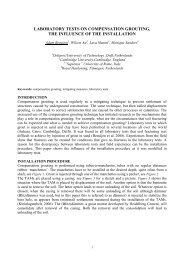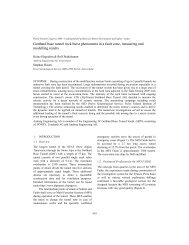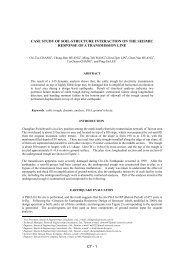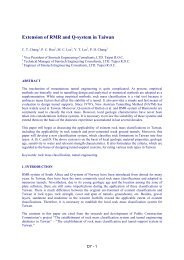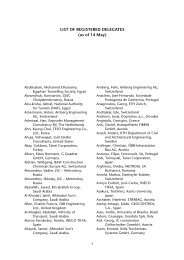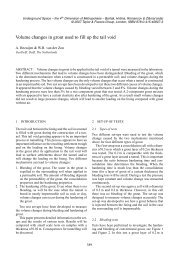Gahir, J.S.
Gahir, J.S.
Gahir, J.S.
Create successful ePaper yourself
Turn your PDF publications into a flip-book with our unique Google optimized e-Paper software.
MAX. DSP=130mm<br />
MAX. DD=4.9mm<br />
WLD -15.9DMD<br />
CRESCENT<br />
NW<br />
SW<br />
SE<br />
MAX. DSP<br />
MAX. DD<br />
WLD<br />
Figure 4.<br />
Dewatering regime and cofferdam monitoring points.<br />
procured from Japan and had a2to3month delivery<br />
time. Used PU25 sections of some 10 m length were<br />
purchased locally and taken to an onsite yard at the top<br />
of the Spine where 20 m lengths were assembled. To<br />
determine the sheet pile drivability a trial was undertaken<br />
near the Spine portal close to a borehole location<br />
using PU series. The piles were spliced and driven to<br />
depths of 33 m using vibrohammer ICE815C (1250 kN<br />
max centrifugal force) without difficulty.<br />
The newly purchased SX27 sections were taken to<br />
Hamriya Port, about 35 km east of the project site,<br />
where they were chamfered and welded to form 30 m<br />
lengths. Hyperseal DPS-1000 was applied to the pile<br />
clutch. This material can expand up to 10 times its<br />
original volume in fresh water but its performance offshore<br />
is curtailed due to the salinity of sea water and<br />
it expands to half the figure. The piles were paired to<br />
form 1.2 m wide panels, so that each prepared offshore<br />
panel comprised of 4 sheet piles, before being barged<br />
to site.<br />
5.3 Onshore sheet piling<br />
Sheet pile sections, 20 m long and 0.6 m wide, were<br />
pitched into a guide frame capable of accommodating<br />
16 sheet piles and driven one by one with a 1.5 m stick<br />
up. Longer sheet piles could not be accommodated<br />
due to limitation of the crane boom. Ten metre long<br />
pile sections were hooked through the guide frame and<br />
spliced to the driven piles. Driving recommenced using<br />
vibrohammer ICE815C and progress was slow due to<br />
difficult driving. Some hard nodules present within the<br />
calcarenite and the wear and tear on the used piles were<br />
felt to contribute to difficult driving. Additionally two<br />
splices in the desired pile length did not always provide<br />
a plumb vertical section and this led to an increase in<br />
the frictional force in the pile clutch.<br />
At some locations especially on the Crescent piles<br />
were terminated 5m short of the required design penetration<br />
due to refusal with the driving system. A<br />
reassessment of the seepage inflow into the cofferdam<br />
was undertaken using k of calcarenite 2×10 −5 m/s<br />
which indicated that the anticipated inflow in this<br />
area increased 9 times locally with the nett effect that<br />
the overall infow into the cofferdam after draining<br />
increased from 820 m 3 /hr to 1600 m 3 /hr. To cope with<br />
the additional inflow contingency measures were put<br />
in place and comprised of (a) drive secondary short<br />
length sheet piles in local areas at the top of the tunnel<br />
trench excavation (b) increase the number of wells and<br />
(c) increase pump capacity.<br />
5.4 Offshore sheet piling<br />
Offshore piling was undertaken from 2 barges, each<br />
with a 150T crane, and the prepared panels 30 m long<br />
and 1.2 m wide, were driven through a guide frame<br />
using a double clutch vibrohammer ICE1412 (2300 kN<br />
max centrifugal force). The contractor reported difficult<br />
driving conditions which required greater effort<br />
1300



